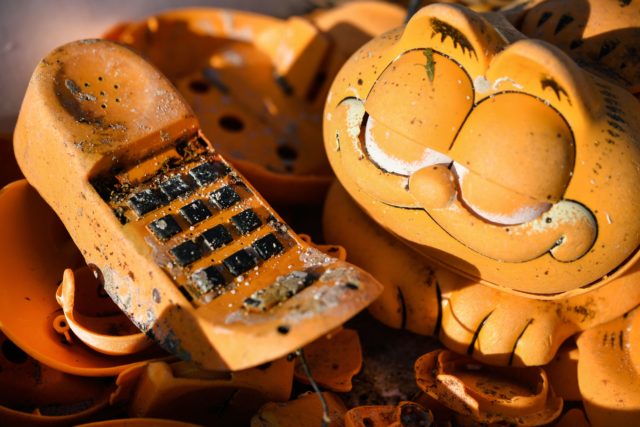When Garfield was rising to fame in the late 1970s and early ’80s, companies were popping out all kinds of merchandise centered on the lazy orange cat. One of the more unusual novelty items was a landline telephone shaped like the fat feline. With eyes that only opened when the receiver was lifted, this item was a collector’s jackpot. However, a real mystery started when parts of these wacky phones began washing up on beaches in France year after year. Finally, the mystery was solved… but it wasn’t really worth celebrating.
Garfield phones mysteriously started washing ashore

As early as the 1980s, different fragments of novelty Garfield landline phones have been washing up on the shore of a stretch of coastline in Brittany, France. For over 30 years, the bright orange pieces, including grinning faces, eyes, dial pads, and wires, have littered the beaches – much to the distress of environmentalists. Where they were coming from remained a mystery for a long time.
Despite efforts to clean up the beaches, these Garfield phones just kept coming back. In 2018, as many as 200 Garfield phone parts were found along the sandy beach line. There was a commonly-held belief that perhaps they were coming from a lost shipping container located at the bottom of the ocean.
However, the mystery was solved when a local farmer, René Morvan, pointed out where he had once seen the Garfield paraphernalia in bulk when he was younger.
A local farmer guided the way to the source

Morvan met with Claire Simonin-Le Meur, the president of an environmental group, to show her where he had spotted the Garfield landline phones back in the 1980s. He recalled having explored the area with his brother following a massive storm in 1983 that began washing the bright orange plastic ashore. This is when he discovered the shipping container full of Garfield phones.
Earlier theories were partially correct. The Garfield phones were coming from a lost shipping container, but it had not sunk to the bottom of the sea. Instead, the container was tucked away in a sea cave. “We have no idea what happened at the time, where it came from, what ship it was or if one or several containers fell in the sea,” said Fabien Boileau, the director of the Natural Sea Park of Iroise. For the majority of the year, the cave is inaccessible to people as a result of the high tides, but when it reached low tide, volunteers were able to venture into the container themselves.
“We found this incredible cave, that was 30 metres deep and right at the end the remains of the container,” Simonin-Le Meur said. “At the cave opening there was a Garfield lodged in the roof, so we knew we weren’t mistaken and this was where they were.” Hoping to find the container still full of paraphernalia, what they found was quite the opposite. “What we found was the remainder of the shipping container. And it was empty.”
A full container would mean being able to remove all of that potential plastic pollution from the ocean. However, after sitting for years with Garfield phones drifting away and onto the shores, it is no surprise that the container was almost empty.
The Garfield phones are an example of a larger problem

However mysterious and strange it may seem for these bright orange Garfield phones to litter the shoreline, they are part of a much larger issue – plastic pollution in the oceans. Previous estimates suggest that somewhere between 4.8 million and 12.7 million tons of plastic enter the earth’s oceans every year.
The fact that the Garfield phones arrive on shore relatively intact proves the long-term consequences of plastic pollution, especially as it takes far longer for these kinds of materials to degrade. Even when they do degrade, they don’t disappear fully, and instead, break down into “microplastics.” These microplastics are then consumed by marine wildlife and eventually climb up the food chain and into human biology. An estimated 70,000 microplastic particles are consumed by Americans every year.
More from us: UFO Hunters Meet at This Mysterious Mailbox Located Outside Area 51
Despite having solved the mystery of the seemingly random appearance of Garfield phones on the beaches in France, environmentalists are disheartened to know they arrived too late. “[T]he bulk of the phones are already gone, the sea has done its job for 30 years,” Simonin-Le Meur said. “We arrive after the battle.”
